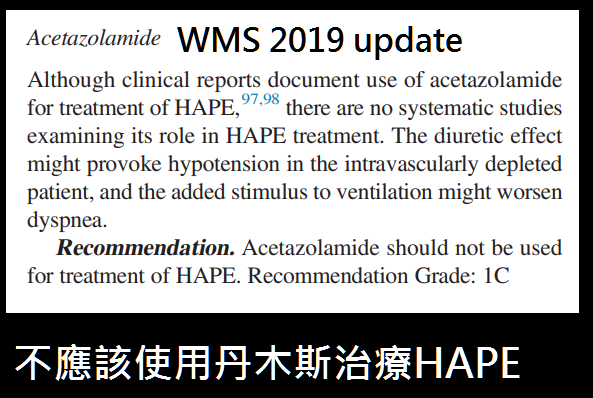答案: 目前醫學證據顯示, 丹木斯可用於預防再返性 re-entry HAPE.
但不建議用於預防一般的 HAPE
丹木斯可用於預防 re-entry HAPE(再返性HAPE)
Despite evidence that acetazolamide hastens acclimatization and blunts hypoxic pulmonary vasoconstriction in animal models and a single study in humans, no data support a role in HAPE prevention. A randomized, placebo-controlled, double-blind study of 13 healthy unacclimatized lowlanders with a history of HAPE found no significant reduction in the incidence of HAPE or pulmonary artery pressure after rapid ascent to 4559 m in those taking acetazolamide compared with placebo despite reductions in AMS and improved oxygenation.
Clinical observations suggest that acetazolamide may prevent re-entry HAPE,
122 a disorder seen in individuals who reside at high altitude, travel to lower elevation, and then develop HAPE upon rapid return to their residence.
Recommendation
We recommend that acetazolamide not be used for HAPE prevention in those with a history of the disease during prior trips to high altitude. Strong recommendation, moderate-quality evidence.
Recommendation
122 a disorder seen in individuals who reside at high altitude, travel to lower elevation, and then develop HAPE upon rapid return to their residence.
Recommendation
We recommend that acetazolamide not be used for HAPE prevention in those with a history of the disease during prior trips to high altitude. Strong recommendation, moderate-quality evidence.
Recommendation
We suggest that acetazolamide be considered for prevention of re-entry HAPE in people with a history of the disorder. Weak recommendation, moderate-quality evidence.
2013年 NEJM 的文章. Acute High Altitude illness 表格有寫. 類固醇可用於預防HAPE

這段是節錄自 2019 WMS update
學理上. 丹木斯應該可以預防HAPE. 但目前並無足夠研究支持這種看法
但在動物實驗和一篇人體試驗, 發現丹木斯可以降低肺動脈壓. 而肺動脈壓升高是發生高海拔肺水腫的重要機轉. 另外. 高海拔居民來到平地(低海拔)一段時間, 重新回到高海拔地區會發生"再返性高海拔肺水腫" reentry HAPE", 臨床觀察發現丹木斯能預防這種問題.
建議: 關於服用丹木斯預防HAPE. 目前缺乏研究資料, 無法證實
建議: 如果患者曾發生 reentry HAPE, 可考慮使用丹木斯預防. (如果過去不曾發生則不一定需要)
我自己的補充:
在低海拔(就是多數台灣人居住的海拔). 急性肺水腫通常來自於心臟衰竭或體液增加(例如洗腎患者), 急診室的治療. 還有小便的患者可以打利尿劑(常用的是furosemide). 將體液總量降低. 但高海拔肺水腫的患者, 往往合併全身脫水. 給予利尿劑 furosemide 不但無效. 還可能有害.
2001年NEJM的指引有一小段文章提到 furosemide. 當時認為 furosemide 無法預防 HAPE. 但對於 furosemide 是否能治療 HAPE 仍有爭議. 但 2013 年 NEJM 高海拔疾病指引, 明確寫上 furosemide 無法治療 HAPE)
Acetazolamide
Because acetazolamide hastens acclimatization, it should be effective at preventing all forms of acute altitude illness. It has also been shown to blunt hypoxic pulmonary vasoconstriction, a key factor in HAPE pathophysiology, in animal models86e88 and in a single study in humans,89 but there are no data specifically supporting a role in HAPE prevention. Clinical observations suggest acetazolamide may prevent reentry HAPE,90 a disorder seen in individuals who reside at high altitude, travel to lower elevation, and then develop HAPE upon rapid return to their residence.
Recommendation.
Because of lack of data, no recommendation can be made regarding use of acetazolamide for HAPE prevention.
Recommendation. Acetazolamide can be considered for prevention of reentry HAPE in people with a history of the disorder. Recommendation Grade: 1C
但要注意. WMS 2019 update 提到, 丹木斯不建議用於治療HAPE.

2013年 NEJM 的文章. Acute High Altitude illness 表格有寫. 類固醇可用於預防HAPE

這段是節錄自 2019 WMS update
學理上. 丹木斯應該可以預防HAPE. 但目前並無足夠研究支持這種看法
但在動物實驗和一篇人體試驗, 發現丹木斯可以降低肺動脈壓. 而肺動脈壓升高是發生高海拔肺水腫的重要機轉. 另外. 高海拔居民來到平地(低海拔)一段時間, 重新回到高海拔地區會發生"再返性高海拔肺水腫" reentry HAPE", 臨床觀察發現丹木斯能預防這種問題.
建議: 關於服用丹木斯預防HAPE. 目前缺乏研究資料, 無法證實
建議: 如果患者曾發生 reentry HAPE, 可考慮使用丹木斯預防. (如果過去不曾發生則不一定需要)
我自己的補充:
在低海拔(就是多數台灣人居住的海拔). 急性肺水腫通常來自於心臟衰竭或體液增加(例如洗腎患者), 急診室的治療. 還有小便的患者可以打利尿劑(常用的是furosemide). 將體液總量降低. 但高海拔肺水腫的患者, 往往合併全身脫水. 給予利尿劑 furosemide 不但無效. 還可能有害.
2001年NEJM的指引有一小段文章提到 furosemide. 當時認為 furosemide 無法預防 HAPE. 但對於 furosemide 是否能治療 HAPE 仍有爭議. 但 2013 年 NEJM 高海拔疾病指引, 明確寫上 furosemide 無法治療 HAPE)
Acetazolamide
Because acetazolamide hastens acclimatization, it should be effective at preventing all forms of acute altitude illness. It has also been shown to blunt hypoxic pulmonary vasoconstriction, a key factor in HAPE pathophysiology, in animal models86e88 and in a single study in humans,89 but there are no data specifically supporting a role in HAPE prevention. Clinical observations suggest acetazolamide may prevent reentry HAPE,90 a disorder seen in individuals who reside at high altitude, travel to lower elevation, and then develop HAPE upon rapid return to their residence.
Recommendation.
Because of lack of data, no recommendation can be made regarding use of acetazolamide for HAPE prevention.
Recommendation. Acetazolamide can be considered for prevention of reentry HAPE in people with a history of the disorder. Recommendation Grade: 1C
但要注意. WMS 2019 update 提到, 丹木斯不建議用於治療HAPE.



 下下面這張圖下面這張圖仍是 WMS 2019 update 的內容.
下下面這張圖下面這張圖仍是 WMS 2019 update 的內容. 